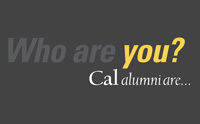The direct mail makeover by Cal fundraisers highlights the cultural contributions of alumni and asks other alumni to support the next generation of innovators, while also thanking the graduates “for being who you are.â€Â
The brilliance of this approach is not in its originality – it rarely is. Using famous alumni is not new. Asking alumni to support future generations is not new. And yet it works beautifully. What is new is the twist on these concepts. What’s new is the juxtaposition of meaningful cultural icons that came out of Cal alumni and inviting other alumni to think of themselves as peers to those innovators.
I’m one of those slightly disaffected Cal alums who Virginia Gray, Cal’s associate director of annual giving and regional programs, is trying to squeeze some bucks out of. I enjoyed my time there and appreciate the education I received, but I feel no special connection to any particular people or places on the campus. But this piece grabbed me.
Rather than talking about all the Nobel Laureates and other Big Brains who went to Cal, the piece talks about their impacts in images and words that are relevant to me, right now. A computer mouse. Saving the planet through energy efficiency. MySpace. Apple, Inc. Dilbert. Bono on the cover of Rolling Stone. This piece of mail takes an education at Cal that happened decades ago and makes it meaningful to my life today. It makes it incredibly easy for me to see how my contribution will lead to the next great thing I’ll have on my desk tomorrow.
Remember: They started with a cookie cutter. “We tried it one way, and it didn’t work out, but we kept going. The new idea was really good, and the copywriting and graphics told a great story,†says Virginia.
I admit, my interest in this piece was piqued first by professional curiosity. When I saw the big, yellow “You†on the cover panel after getting years of canned letters from Cal, my first thought was, “OK, somebody just took some donor marketing training and has gulped down a big cup of the ‘You-Not-Us’ Kool-Aid.†But when I opened it up and read the piece, I immediately felt like I was part of this amazing group of innovators simply by virtue of being an alumna. Check one slacker alumna off your list, Virginia. I gave online for the first time since I graduated in ’91.
Virginia is new to nonprofit marketing, but she has a strong direct marketing and branding background and knows the importance of finding emotional hooks. Her focus groups told her what she already knew. Cal is huge and there are not a lot of common experiences there that create unifying emotions in alumni. But those same alumni also told her what their hot buttons were — that they weren’t cookie-cutter Ivy League graduates and yet were proud to have graduated from one of the top universities in the nation.
Did it work on other alumni as well as it did with me? We’ll see. The mailing list includes 100,000 graduates of Cal’s College of Letters & Science who are not currently donors. The list was not broken out by age or other demographics. Half got the full-color brochure and the other half got a standard business letter with similar messaging in much longer text and no graphics. See the Brochure. See the Letter.
Virginia says it takes a good two-three months before they can judge the performance of a direct mail campaign, but she will pull the first numbers at the end of November and has agreed to share them with us. By split testing similar messages in drastically different formats and comparing them to other campaigns, she hopes to determine what was more important to success: the message, the package, or both.
We’ll find out in a few weeks. Stay tuned by subscribing to this blog right now (see upper left of blog home page), so you don’t miss the results!
Coming Tomorrow: Lessons you can learn from what Cal did





